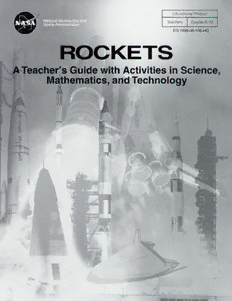
NASA clip art PDF
Preview NASA clip art
ROCKETS A Teacher's Guide with Activities In Science, Mathematics, and Technology National Aeronautics and Space Administration Office of Human Resources and Education Education Division Washington, DC Education Working Group NASA Johnson Space Center Houston, Texas This publication is in the Public Domain and is not protected by copyright. Permission is not required for duplication. EG-1999-06-108-HQ Acknowledgments This publication was developed for the National Aeronautics and Space Administration with the assistance of hundreds of teachers in the Texas Region IV area and educators of the Aerospace Education Services Program, Oklahoma State University. Writers: Deborah A. Shearer Gregory L. Vogt, Ed.D. Teaching From Space Program NASA Johnson Space Center Houston, TX Editor: Carla B. Rosenberg Teaching From Space Program NASA Headquarters Washington, DC Special Thanks to: Timothy J. Wickenheiser Chief, Advanced Mission Analysis Branch NASA Lewis Research Center Gordon W. Eskridge Aerospace Education Specialist Oklahoma State University Dale M. Olive Teacher, Hawaii i ii Table of Contents How To Use This Guide...............................1 Activity Format .............................................3 Brief History of Rockets................................5 Rocket Principles .......................................13 Practical Rocketry ......................................18 Launch Vehicle Family Album....................25 Activities.....................................................35 Activity Matrix.......................................36 Pop Can Hero Engine ..........................39 Rocket Car ...........................................45 3-2-1 Pop! ............................................53 Antacid Tablet Race.............................57 Paper Rockets......................................61 Newton Car ..........................................67 Balloon Staging....................................73 Rocket Transportation..........................76 Altitude Tracking ..................................79 Bottle Rocket Launcher........................87 Bottle Rocket........................................91 Project X-35 .........................................95 Additional Extensions.........................114 Glossary...................................................115 NASA Educational Materials....................116 Suggested Reading..................................116 Electronic Resources for Educators.........117 NASA Educational Resources .................118 NASA Teacher Resource Center Network .................................119 Evaluation Reply Card ..........................Insert iii iv How To Use This Guide Rockets are the oldest form of self-contained vehicles in existence. Early rockets were in use more than two thousand years ago. Over a long and exciting history, rockets have evolved from simple tubes filled with black powder into mighty vehicles capable of launching a spacecraft out into the galaxy. Few experiences can compare with the excitement and thrill of watching a rocket-powered vehicle, such as the Space Shuttle, thunder into space. Dreams of rocket flight to distant worlds fire the imagination of both children and adults. With some simple and inexpensive materials, you can mount an exciting and productive unit about rockets for children that incorporates science, mathematics, and technology education. The many activities contained in this teaching guide emphasize hands-on involvement, prediction, data collection and interpretation, teamwork, and problem solving. Furthermore, the guide contains background information about the history of rockets and basic rocket science to make you and your students “rocket scientists.” The guide begins with background information on the history of rocketry, scientific principles, and practical rocketry. The sections on scientific principles and practical rocketry focus on Sir Isaac Newton’s Three Laws of Motion. These laws explain why rockets work and how to make them more efficient. Following the background sections are a series of activities that demonstrate the basic science of rocketry while offering challenging tasks in design. Each activity employs basic and inexpensive materials. In each activity you will find construction diagrams, material and tools lists, and instructions. A brief background section within the activities elaborates on the concepts covered in the activities and points back to the introductory material in the guide. Also included is information about where the activity applies to science and mathematics standards, assessment ideas, and extensions. Look on page 3 for more details on how the activity pages are constructed. Because many of the activities and demonstrations apply to more than one subject area, a matrix chart identifies opportunities for extended learning experiences. The chart indicates these subject areas by activity title. In addition, many of the student activities encourage 1 Rockets: A Teacher's Guide with Activities in Science, Mathematics, and Technology EG-1999-06-108-HQ student problem-solving and cooperative your assistance in improving this guide in future editions learning. For example, students can use by completing the questionnaire and making problem-solving to come up with ways to improve suggestions for changes and additions. the performance of rocket cars. Cooperative learning is a necessity in the Altitude Tracking A Note on Measurement and Balloon Staging activities. The length of time involved for each In developing this guide, metric units of activity varies according to its degree of difficulty measurement were employed. In a few and the development level of the students. With exceptions, notably within the "Materials and the exception of the Project X-35 activity at the Tools" lists, English units have been listed. In the guide's end, students can complete most United States, metric-sized parts such as screws activities in one or two class periods. and wood stock are not as accessible as their Finally, the guide concludes with a glossary of English equivalents. Therefore, English units terms, suggested reading list, NASA educational have been used to facilitate obtaining required resources including electronic resources, and an materials. evaluation questionnaire. We would appreciate 2 Rockets: A Teacher's Guide with Activities in Science, Mathematics, and Technology EG-1999-06-108-HQ Activity Format Objectives of the Activity Description of What Assessment Ideas the Activity Does Standards Background Information Materials and Tools Extensions Management Tips Discussion Ideas What You Need Student Data Pages Student Instruction Pages 3 Rockets: A Teacher's Guide with Activities in Science, Mathematics, and Technology EG-1999-06-108-HQ
